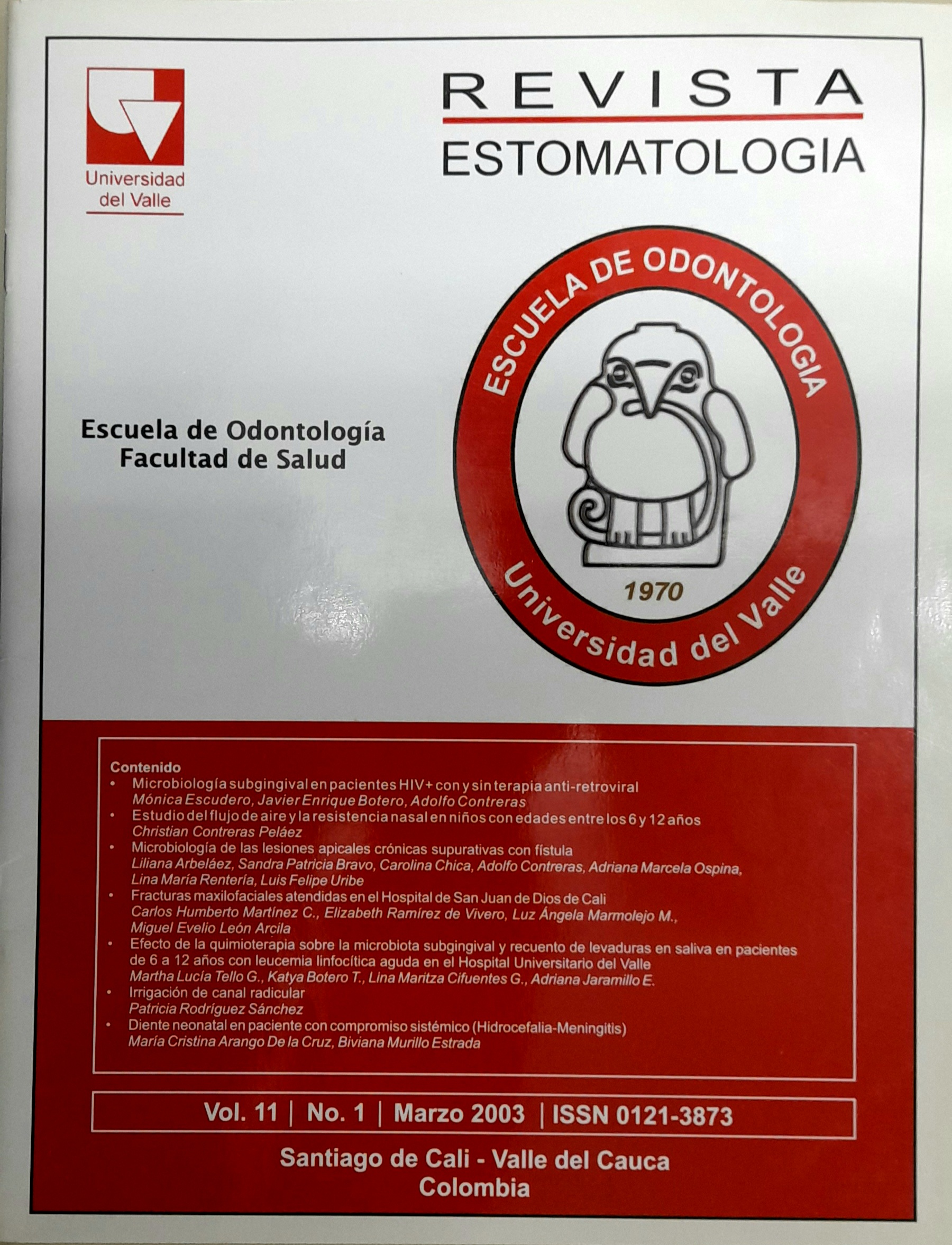Microbiología subgingival en pacientes HIV+ con y sin terapia anti-retroviral
Keywords:
Subgingival microbiota ; Microbial culture ; Anti-retroviral therapy ; HIV periodontitis ; HIV gingivitis ;Main Article Content
The oral cavity could be the primary place for the establishment oflesions associated with HIV infection inc1uding leukoplasia, Kaposi sarcoma, oral candidiasis, ulcerative gingivitis and periodontitis. This study evaluated the subgingival microbiota and periodontal status in HIV (+) patients with and without anti-retroviral therapy. Twenty two subjects with anti-retroviral therapy and nine subjects without treatment anti-retroviral therapy participated voluntarily in the study, which was approved by the committee on human research ofthe Universidad del Valle. Clinical data including bleeding on probing, suppuration, pocket probing depth, mobility andplaque index were recorded. Subgingival microbial samples were collected from the deepest sites for culturing analysiso Statistical analysis was carried out using the Pearson correlation test, Friedman test and SSPS software for Windows (p<0.05). Different states of severity in the periodontallesions and a subgingival microbiota that encompassed gram negative enteric rods, Fusobacterium spp and Porphyromonas gingivalis were observed. A detailed description of findings is given in the results ofthe study. On considering the limitations ofthe study, antiretroviral therapy did not influence the subgingival microbiota and periodontal state in HIV (+) patients. The subgingival microbiota appears to be similar to that found in normal patients with periodontal disease. The role of gram negative enteric rods in the etiopathogenesis of periodontal disease requires further research in the future.
- Judy Villavicencio, Adolfo Contreras, Jesus Hernández Silva, Freddy Moreno, Half Century of creation and progress at the Dental School - Universidad del Valle, Cali - Colombia: relevant achievements in the last decade , Revista Estomatología: Vol. 27 No. 2 (2019)
- Juan Diego García Castaño, Mario Julián Gómez Palacios, Juan Pablo Rosales Mora, Adolfo Contreras, Microbiología en pericoronitis aguda de terceros molares mandibulares , Revista Estomatología: Vol. 11 No. 2 (2003)
- Adolfo Contreras, Roger Mauricio Arce, Javier Enrique Botero, Adriana Jaramillo, Contaminación bacteriana de cepillos dentales en niños y sus padres: una cuestión de educación , Revista Estomatología: Vol. 10 No. 2 (2002)
- Paola Andrea Gaviria , Heidy Liliana Rosales, Adolfo Contreras, Contaminación in vitro de cepillos dentales , Revista Estomatología: Vol. 9 No. 2 (2001)
- Eliana Cadena, Jessica Delgado, Diana Peña, Paola Sánchez, Sonia Gutiérrez, Adolfo Contreras, Adriana Jaramillo, Anilza Bonelo Contreras, Effectiveness of antibacterial dental brushes. In vitro study , Revista Estomatología: Vol. 22 No. 1 (2014)
- Adolfo Contreras, Adriana Jaramillo, Freddy Moreno, Carlos Valencia, First meeting of the research groups of School of Dentistry at the Universidad del Valle “Constructing research strategies.” Opinion article , Revista Estomatología: Vol. 19 No. 2 (2011)
- Adolfo Contreras R., Miryam Astudillo, Graciela Barona, Fabio Carmona, Aristides Baraya, Efecto inhibitorio del triclosán al 0.2% y citrato de zinc al 0.02% sobre bacterias cariogénicas y periodontopatogénicas (in vitro) , Revista Estomatología: Vol. 6 No. 1 (1996)
- Myriam Astudillo, Adolfo Contreras, Diagnóstico preliminar de esterilización en 60 consultorios odontológicos de Cali , Revista Estomatología: Vol. 3 No. 1 (1993)
- Adolfo Contreras, Avances en inmunología y respuesta del huésped en enfermedad periodontal , Revista Estomatología: Vol. 3 No. 2 (1993)
- Sandra Amaya, Maria F. Bolaños, Adriana Jaramillo, Jorge E. Soto, Adolfo Contreras, Estado periodontal y microbiota subgingival en mujeres preeclámpticas , Revista Estomatología: Vol. 12 No. 2 (2004)

This work is licensed under a Creative Commons Attribution-NonCommercial-NoDerivatives 4.0 International License.
Los autores/as conservan los derechos de autor y ceden a la revista el derecho de la primera publicación, con el trabajo registrado con la licencia de atribución de Creative Commons, que permite a terceros utilizar lo publicado siempre que mencionen la autoría del trabajo y a la primera publicación en esta revista.





